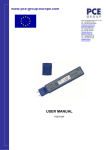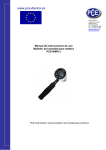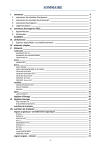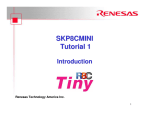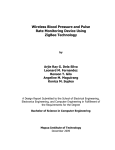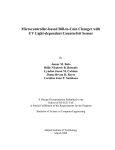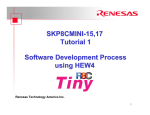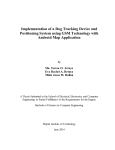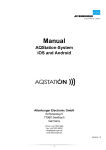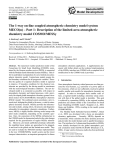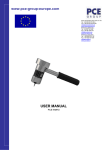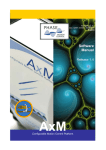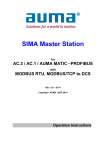Download A Process Automation Of A Conventional Manually
Transcript
A Process Automation Of A Conventional Manually-Triggered Liquid Soap Dispenser By Mark Henrison C. Ong Brent E. Ordoño Lerwin Chris U. Tan A Design Report Submitted to the School of Electrical Engineering, Electronics and Communications Engineering, and Computer Engineering in Partial Fulfilment of the Requirements for the Degree Bachelor of Science in Computer Engineering Mapua Institute of Technology January 2009 i Mapua Institute Of Technology School of EE-ECE-COE This is to certify that we have supervised the preparation of and read the design report prepared by Mark Henrison C. Ong, Brent E. Ordoño and Lerwin Chris U. Tan entitled A Process Automation Of A Conventional ManuallyTriggered Liquid Soap Dispenser and that the said report has been submitted for final examination by the Oral Examination Committee. __________________ Blesilda M. Pantoja Reader __________________ Maribelle Pabiania Design Adviser _________________ Analyn N. Yumang Design Adviser As members of the Oral Examination Committee, we certify that we have examined this design report, presented before the committee on November 29, 2008, and hereby recommend that it be accepted as fulfillment of the design requirement for the degree in Bachelor Of Science In Computer Engineering. ___________________ Carlos Hortinela IV Panel member _________________ Joyce M. Santos Panel member ___________________ Eliseo D. Francisco Panel member This design report is hereby approved and accepted by the School of Electrical Engineering, Electronics and Communications Engineering and Computer Engineering as fulfillment of the design requirement for the degree in Bachelor of Science in Computer Engineering. __________________ Felecito S. Caluyo Dean, School of EE-ECE-COE ii ACKNOWLEDGMENT The group would like to first and foremost express their gratitude to God for giving them enough determination and guidance to successfully carry out the objectives and meet the requirements of the design project. Secondly, the group would like to thank their friends and family members who helped in the conceptualization of the project as a whole, most especially their parents for giving them support and guidance in this endeavor. Thirdly, the group would also like to thank Engr. Analyn Yumang, for the support and invaluable guidance she gave them to be prepared for the oral defense and for spending important time to check their project documentation until finally solid. They also would like to thank the panel: Engr. Eliseo D. Francisco, Engr. Carlos Hortinela IV, and Engr. Joyce Santos for accepting the invitation and cooperating with the changing defense schedules. Lastly, the group would like to express their utmost and sincerest appreciation to their beloved instructor, Engr. Noel B. Linsangan for providing them the most important lessons that they need in life and for assisting them in this endeavor. ONG, Mark Henrison C. ORDOÑO, Brent E. TAN, Lerwin Chris U. iii TABLE OF CONTENTS TITLE PAGE……………………………………………………………………………………………….i APPROVAL SHEET.......................................................................................ii ACKNOWLEDGMENT……………………………………………………………………………….iii TABLE OF CONTENTS………………………………………………………………………………iv LIST OF TABLES……………………………………………………………………………………....v LIST OF FIGURES………………………………………………………………………..………….vi ABSTRACT…………………………………………………………………………….…………………vii Chapter 1: DESIGN BACKGROUND AND INTRODUCTION........................1 A. Frame of reference……………………………………………………………..1 B. Statement of the problem……………………………………………………2 C. Objective of the design……………………………………………………….2 D. Significance of the design…………………………………………………….3 E. Conceptual framework…………………………………………………………4 F. Scope and delimitation………………………………………………………..5 G. Definition of terms………………………………………………………………6 Chapter 2: REVIEW OF RELATED LITERATURE AND STUDIES……………..12 Chapter 3: DESIGN METHODOLOGY AND PROCEDURES………………………15 Chapter 4: TESTING, PRESENTATION AND INTERPRETATION OF DATA…24 Chapter 5: CONCLUSION AND RECOMMENDATION…………………………..…33 BIBLIOGRAPHY………………………………………………………………….................…..35 APPENDICES……………………………………………………………………………………………36 Appendix A: Program Listing………………………………………………………..36 Appendix B: PCB Layouts………………………………………………………………40 Appendix C: User’s Manual……………..…………………………………………….41 Appendix D: Installation Manual...................................................46 Appendix E: PIC16f84A Data Sheet…………………………………………….48 iv LIST OF TABLES Table Table Table Table Table 1: 2: 3: 4: 5: Comparative analysis…………………………………………………………………….24 Normal operation………………………………………………………………………….27 Maximum operation………………………………………………………………………29 Conventional liquid soap dispenser operation…………………………………..31 Level indicator probe test………………………………………………………………31 v LIST OF FIGURES Figure Figure Figure Figure Figure Figure Figure Figure 1: 2: 3: 4: 5: 6: 7: 8: Framework diagram………………………………………………………………………4 Design Flow Diagram…………………………………………………………………..16 System block diagram………………………………………………………………….18 Schematic diagram……………………………………………………………………...18 Foil Pattern layout……………………………………………………………………….19 PCB layout………………………………………………………………………………….19 List of materials and specifications………………………………………………..20 Structured system operation…………………………………………………………21 vi ABSTRACT This design project is all about liquid soap dispenser automation. A conventional soap dispenser container available in the market was used for the conceptualized design which functions through interfaced electronic components such as sensors, a microcontroller, a motor and a switch among others. This project aims to reinvent the existing manualoriented design to make a simple yet significant change in the way people wash their hands. In the course of the design procedure, the researchers saw the need to adjust the flow control of the device in dispensing so that there is consistency in the amount given off. Consequently, the researchers were able to conclude that compared to conventional, manually-triggered liquid soap dispensers, the design prototype proved to be more ergonomic, efficient, and hygienic. Keywords: liquid thickness, sensors, switches, PIC microcontroller vii Chapter 1 DESIGN BACKGROUND AND INTRODUCTION A. Frame of reference With the rapid progressive change in technology, work is made more convenient through innovations that provide man with a faster way of doing his task. Not only this, technological advancement has also given solution to strenuous activities that people do every day, either simple or burdensome. Through this trend, household fixtures have slowly been technologically improved that gave them more style and usability. More particularly in the bathroom, flushing the toilet is no more than a push-of-a-button away; taking a shower is more refreshing with digital control over the water’s temperature and a quick rinse is always available by means of bidet wash. Later on, it became evident that sharing a bar of soap in a bathroom is just simply unhygienic, therefore, liquid soap was made. Liquid soap dispensers operate with the use of a manually-triggered pump connected to an extended tube, the diameter of which is the same as the base of the main pump, which sucks the air out through a nozzle. With liquid soap filled higher than the level of the extended tube’s end, the dispensing process is attained and the amount of soap that is given out relies on how much pressure is manually applied on the pump, thus, presenting a more reasonable way of washing hands. Other designs provide an upside down approach to dispensing liquid soap where the pump is located 1 in front of the casing’s base and triggering this pump will open a latch simultaneously with a compartment in vacuum allowing soap to flow through. B. Statement of the problem Liquid soap dispensers, although helpful can also be inconvenient in a longer duration. The main problem, therefore, is based on the elimination of contact to the device in the dispensing of the liquid soap. The manual process of doing it mostly leads to a repetitive process of activating the pump until the desired amount of liquid soap is obtained. A dispenser with a low amount of liquid soap in it is also rather inconsistent since a high pressure applied to the pump will result to a sudden scattering of soap. In other cases where the manual trigger is placed near the base, the issue of whether it is hygienic or not is raised because still, the device comes in contact with the user’s hand. The existing design is plain and lacks enough character to become more user-friendly. Because of its container, it will be an intricate task to refill the container which is very important most especially for commercial uses. C. Objective of the design The general objective of the design project aims to automate the manually-triggered liquid soap dispenser and improve its functionality more by adding features that the previous designs did not have. Specifically, what the group aims to enhance is the functionality of dispensing liquid soap without having to make contact with the device itself. It is also the group’s specific 2 objective to include a level indicator which will show how much liquid soap is contained inside the device. This will help in refilling the container which is one of the problems in having a dispenser more importantly for commercial uses. The level indicator also adds a user-friendly application in this way because it somehow makes the refilling part interactive. D. Significance of the design The design project provides a simple yet significant device that is a development of a previously accepted system. It is more hygienic because no physical contact between the user and the device is required, while the amount of liquid soap dispensed is always in agreement to the variable period applied by the user for every use and may not be abused. The design has taught every member of the group to value and manage their time and able to work under pressure. The previous courses which the group has taken in their lower years like Electronics, Logic circuits, Circuit analysis and those which had design prototypes as course requirement proved to have given them invaluable knowledge in coming up with a meaningful design prototype. For the school, the design prototype may be used to replace existing liquid soap dispenser to aid the school in promoting cutting edge technology and add sophistication to the school’s overall operation should accreditors visit it again. For the society, this design will provide opportunities because the concept may still be improved while the design is in itself helpful to commercial establishments either already 3 having liquid soap dispensers or not, to upgrade their system and attract more customers whatever business they may have. E. Conceptual framework Variables that affect the device’s operation include the period taken by the user to acquire an amount of liquid soap which could be categorized in the prototype’s operation as in normal or maximum state. The time it will take for the device to react on an input made through the IR sensor will also determine how consistent the device is in giving off the soap. The effect of these factors was tested in Chapter 4 to identify the behaviour of the design prototype under conditions involving them. Conceptual Framework Diagram: INDEPENDENT VARIABLES 1. Container capacity 2. Time taken by the user to use the device INTERVENING VARIABLES 1. Microcontroller 2. Lever arm 3. Limit switch DEPENDENT VARIABLES 1. Level sensor 2. Infrared sensor 3. Liquid soap Figure 1: Framework Diagram Figure 1 illustrates the framework diagram of the system’s correlation of variables involved in the automated system’s operation. The input mainly comes from the blocking object which is recognized by the infrared sensor. The level sensors, on the other hand, depend on the number of times the liquid soap in the container depletes per use. Consequently, the liquid soap remaining in the casing depends on how many times the device is already used. As stated, 4 depletion is constant per use. The independent variables are the container’s capacity because this cannot be changed but can only be refilled. The time taken by the user to acquire liquid soap is also independent of any of the variables stated above since it will rely on the user’s prerogative the duration of the operation per use. The intervening variable is the microcontroller since it manages the operation of the whole system and it is the actual processor of the independent variables to drive the dependent variables. The lever arm on the other hand controls the dispensing action and allows liquid soap to flow from the container while the limit switch identifies the boundary by which the lever arm will rotate. F. Scope and delimitation The study covers the operation of the automated dispenser prototype in dispensing liquid soap as compared to manually-triggered liquid soap dispensers. This study also engages in demonstrating the ergonomics behind the design prototype’s transparency in its functions and interface. Automation is perceived to be done by using infrared and lever sensors, DC motor and relay, a lever arm with a limit switch which are all interfaced to a PIC16F84A microcontroller to effectively dispense liquid soap. The proposed design project, however, does not include a working price for public consumption or for other commercial sale. The manufacturing cost may be affected by a lot of factors, hence, it is not specified. In addition, the dispensing device may only use liquid substances with the same thickness of liquid soap. Due to accumulated air in the installed tube to access 5 the liquid soap, there may be cases when the dispenser will give drops of liquid soap even after its actual operation. G. Definition of terms Bridge rectifier is an arrangement of four diodes in a bridge configuration that provides the same polarity of output voltage for either polarity of input voltage. When used in its most common application, for conversion of alternating current (AC) input into direct current (DC) output, it is known as a bridge rectifier. A bridge rectifier provides full-wave rectification from a two-wire AC input, resulting in lower cost and weight as compared to a center-tapped transformer design, but has two diode drops rather than one, thus exhibiting reduced efficiency over a center-tapped design for the same output voltage. (Fundamentals of Electric Circuits, Alexander & Sadiku) Capacitor is a passive electrical component that can store energy in the electric field between a pair of conductors called plates. The process of storing energy in the capacitor is known as "charging", and involves electric charges of equal magnitude, but opposite polarity, building up on each plate. A capacitor's ability to store charge is measured by its capacitance, in units of farads. (Fundamentals of Electric Circuits, Alexander & Sadiku) Crystal resonator is an electronic circuit that uses the mechanical resonance of a vibrating crystal of piezoelectric material to create an electrical signal with a very precise frequency. This frequency is commonly used to keep track of time, 6 to provide a stable clock signal for digital integrated circuits, and to stabilize frequencies for radio transmitters or receivers. (Fundamentals of Electric Circuits, Alexander & Sadiku) Direct current (DC) is the unidirectional flow of electric charge. Direct current is produced by such sources as batteries, thermocouples, solar cells, and commutator-type electric machines of the dynamo type. It may be obtained from an alternating current supply. (Bill To Coin Changer, Buenafe & Catalan) Direct current motor (DC motor) convert electric power into mechanical work. This is accomplished by forcing current through a coil and producing a magnetic field that spins the motor. (Fundamentals of Electric Circuits, Alexander & Sadiku) Electrically Erasable Programmable Read-Only Memory (EEPROM) is a non volatile storage chip used in computers and other devices to store small amounts of volatile data like calibration tables and device configurations. (Fundamentals of Electric Circuits, Alexander & Sadiku) Electrolytic capacitor is a type of capacitor that uses an ionic conducting liquid as one of its plates. Typically with a larger capacitance per unit volume than other types, they are valuable in relatively high-current and low-frequency electrical circuits. This is especially the case in power-supply filters, where they store charge needed to moderate output voltage and current fluctuations, in rectifier output. (Fundamentals of Electric Circuits, Alexander & Sadiku) 7 Electromagnetic coil is formed when a conductor, usually a solid copper wire is wound around a core or form to create an inductor or electromagnet. One loop of wire is usually referred to as a turn, and a coil consists of one or more turns. (Fundamentals of Electric Circuits, Alexander & Sadiku) Frequency is the number of occurrences of a repeating event per unit time. It is also referred to as temporal frequency. The period is the duration of one cycle in a repeating event, so the period is the reciprocal of the frequency. (Fundamentals of Electric Circuits, Alexander & Sadiku) Human-Machine Interface (HMI or User interface) is the aggregate of means by which people interact with a particular machine, device, computer program or other complex tools or systems. (Bill To Coin Changer, Buenafe & Catalan) Infrared sensor (IR sensor) contains a matched infrared transmitter and infrared receiver pair. These devices work by measuring the amount of light that is reflected into the receiver. Because the receiver also responds to ambient light, the device works best when well shielded from ambient light, and when the distance between the sensor and the reflective surface is small. (Fundamentals of Electric Circuits, Alexander & Sadiku) Integrated circuit (IC) is a miniaturized electronic circuit that has been manufactured in the surface of a thin substrate of semiconductor material and 8 consists mainly of semiconductor devices as well as passive components. (Bill To Coin Changer, Buenafe & Catalan) Level sensor is used to detect liquid level. The liquid to be measured can be inside a container or can be in its natural form. The level measurement can be either continuous or point values. Continuous level sensors measure level within a specified range and are used to know the exact amount of liquid in a certain place. (Fundamentals of Electric Circuits, Alexander & Sadiku) Light emitting diode (LED) is a semiconductor diode that emits incoherent narrow-spectrum light when electrically biased in the forward direction of the p-n junction, as in the common LED circuit. (Bill To Coin Changer, Buenafe & Catalan) Limit switch are electromechanical devices that require physical contact between a target object and switch activator to make the contacts change state. (Fundamentals of Electric Circuits, Alexander & Sadiku) Microcontroller unit (MCU) is a computer-on-a-chip or a type of microprocessor emphasizing high integration, low power consumption, self sufficiency, and cost effectiveness in contrast to a general-purpose microprocessor. (Bill To Coin Changer, Buenafe & Catalan) Oscillator is the repetitive variation, typically in time, of some measure about a central value often a point of equilibrium or between two or more different states. (Fundamentals of Electric Circuits, Alexander & Sadiku) 9 Phototransistor is a bipolar transistor that is encased in a transparent case so that light can reach the base-collector junction. It works like a photodiode but with a much higher responsivity to light, because the electrons that are generated by the photons in the base-collector junction are injected into the base and this current is then amplified by the transistor operation. (Bill To Coin Changer, Buenafe & Catalan) Relay is an electrical switch that opens and closes under the control of another electrical circuit. this switch is operated by an electromagnet to open or close one or many sets of contacts. (Bill To Coin Changer, Buenafe & Catalan) Resonator is a device or system that exhibits resonance or resonant behavior. It is naturally oscillates at some frequencies, called its resonance frequencies, with greater amplitude than at others. (Fundamentals of Electric Circuits, Alexander & Sadiku) Toggle switch is a class of electrical switches that are actuated by a mechanical lever, handle, or rocking mechanism. Toggle switches are available in many different styles and sizes, and are used in countless applications. (Fundamentals of Electric Circuits, Alexander & Sadiku) Transformer is a device that transfers electrical energy from one circuit to another through inductively coupled electrical conductors. A changing current in the first circuit (the primary) creates a changing magnetic field. This changing magnetic field induces a changing voltage in the second circuit (the secondary). 10 This effect is called mutual induction. (Fundamentals of Electric Circuits, Alexander & Sadiku) Transistor is a semiconductor device that is commonly used as an amplifier or an electrically controlled switch. (Bill To Coin Changer, Buenafe & Catalan) Voltage divider principle known as a voltage divider, a potential divider is a simple linear circuit that produces an output voltage (Vout) which is a fraction of its input voltage (Vin). Voltage division refers to the partitioning of a voltage among the components of the divider. (Fundamentals of Electric Circuits, Alexander & Sadiku) Voltage regulator is an electrical regulator designed to automatically maintain a constant voltage level. It may use an electromechanical mechanism, or passive or active electronic components. Depending on the design, it may be used to regulate one or more AC or DC voltages. (Fundamentals of Electric Circuits, Alexander & Sadiku) Chapter 2 REVIEW OF RELATED LITERATURE AND RELATED STUDIES In a I4U News article entitled “Soap Genie Automatic Soap Dispenser” on February 14 2006, Luigi Lugmayr reviewed an automated soap dispenser named as “The Soap Genie” that automatically dispenses soap by just holding your hand 11 under the dispenser with the use of IR sensors with an extra musical chime when done. He said that it is high tech, fun, and also has some sanitary benefits by using it which finishes by saying that there are no arguments in buying the soap genie. Furthermore, an article by Alan Gettelman of Buildings: For Facilities – Decision Makers which is entitled “There’s No Soap” on July 2003, states that so many times people complain about washrooms running out of soaps which results in scrambling an unscheduled worker taking him away from his regular duties to refill soaps. Allan Gettelman said that dispensers normally require regular attention to keep them full, others are cheap which are not recommended for heavy use. There are also cartridge soap dispensers which use expensive soap. Lastly, he concluded that there is still no conventional soap dispenser that will fully relieve the facility manager from constant attention to soap levels. Morover, Lauran Neergaard in his article in The Herald entitled “Men's hands dirtier than women's, study says” on September 22, 2005 compares men and women in washing their hands after urinating. He affirms that only 25% of male washes while 90% of female washes. When some males were interviewed about not washing after using comfort rooms, they reason out that washing their hands doesn’t guarantee that their hands are already clean because of the doors knobs and faucet they handle contain germs also. 12 In addition, Kim Painter in his article entitled “Yes, Washing Hands Works” in USA Today, on November 6, 2007 explained the importance of washing hands and even asked her readers to comment on why some people do not wash their hands after using the restroom. They responded that they do not urinate on their hands or touch any dirty or unclean body parts. Some said that they do not walk out with any more germs than they came in with while many others said that washing up in dirty and poorly appointed public restrooms might do more harm than good. One person commented that “The invention of no-touch, motiondetecting faucets and soap dispensers is proof that conventional washing is a source of germs.”. Lastly, H. Y. Wong in his Enzine Article entitled “Washing Hands With an Automatic Soap Dispenser Can Avoid Cross Contamination” on October 2006 discussed the simple habit of washing hands with soap and water after going to the toilet. He even suggested that to avoid cross contamination, it is better to use liquid soap instead of a soap bar. In this way, germs will not be deposited and accumulated on the soap bar. Therefore, it is better to use an automatic liquid soap dispenser with quick and easy operation and stated that an ordinary liquid soap dispenser requires a push at the top to dispense soap which leaves the possibility that the top of the dispenser can become contaminated with germs when it is pushed. Lastly, he cited that According to UNICEF, millions of children's lives can be saved in third world countries from diarrhea and pneumonia by the simple habit of washing hands with soap and water after 13 going to the toilet. Chapter 3 DESIGN METHODOLOGY AND PROCEDURES Design Methodology The methodology used to design the proposed prototype was a constructive improvement. Through developing the existing liquid soap 14 dispenser’s capabilities, the strengths and weaknesses of each of the conventional and desired automated system’s operation are revealed and so the enhancement and issues that are needed to be addressed are identified. The group, therefore, found it easier to gather data from automation projects that have been already documented which uses the same resources that they will be using in accordance to some articles that proved to be somehow credible enough to suggest circuit components. Documented automation projects include those found in the school’s library, one of which details the process in coming up with a bill to coin converter. Comparative analysis was also used to determine the improvement made from the conventional soap dispenser design. Comparison will therefore be based on criteria which will evaluate the behaviour of each system in circumstances which it can encounter in its actual operation. Consultation with knowledgeable persons specializing in circuit assembly and analysis regarding the problem was also made to come up with a doable and simple design and estimate the components and materials needed. In consulting, a draft design led to an idea of making a DC motor operate as an output for the proposed project while a simple infrared sensor will be implemented to serve as input. Lastly, the microcontroller is an important component which controls the processes occurring in the system. Design Procedure DATA GATHERING MATERIALS SOURCING CIRCUIT ASSEMBLY 15 Figure 2: Design Flow Diagram Initially, the research team sourced out data from journals relating to liquid soap dispensers. A draft design of the design project was made to have an idea of how the soap dispenser would look like and the materials it will require in assembling. A manual liquid soap dispenser container with one opening will be used to contain the liquid soap and discharge it from the said container. To attain automation, a DC motor connected to a lever arm is used to activate the manual soap dispenser’s pump button and discharge a limited amount of soap intermittently. The DC motor will be activated by an infrared sensor to perform its task, the infrared sensor’s transmitter determines a blocking of light while the receiver is used as an indication for the device to perform the discharging of 16 liquid soap. All signals and tasks will be controlled by the microcontroller, crystal resonator and a relay as the major components, while other components control the incoming voltage from the supply respectively. The crystal resonator will determine the processing speed of the device. The microcontroller is an integrated circuit that contains the control function of the whole device, the program constructed will be giving signals to the operations of the dc motor, infrared sensor and limit switch. The PIC16F84A microcontroller’s operating frequency is 20 MHz clock input in DC mode. On the other hand, the limit switch will be accessed by the DC motor lever arm, the DC motor when activated will perform a clockwise rotation which will activate the limit switch to signal the relay device to reverse the rotation of the dc motor and again when the dc motor reached the other limit switch, it will signal the dc motor to stop the rotation. All electrical components are soldered to the PCB and a step down transformer is used to lower the voltage entering the prototype to avoid excess voltage. Figures 3 and 4 show the system’s block and schematic diagrams, respectively, to demonstrate in detail the parts and operation of the automation pictorially. CRYSTAL RESONATOR IR SENSOR LEVEL SENSORS PIC16F84A Microcontroller DC MOTOR MINI RELAY LED INDICATORS INPUT VOLTAGE TRANSFORMER BRIDGE RECTIFIER 17 FILTER Figure 3: System Block Diagram Figure 4: Schematic Diagram 18 Figure 5: Foil Pattern Layout Figure 6: PCB Layout Figure 5 shows the main circuit’s foil pattern layout detailing the location of the circuit components vital for the system’s operation. The main component of the circuit is the PIC microcontroller because it controls the flow of the operation transpiring within the system. The capacitors serve mainly as filters and aid the microcontroller’s task to automate the liquid soap dispenser’s function. Figure 8, on the other hand, shows the structured flow of actions that are done by the automated liquid soap dispenser itself. It represents the procedures followed by the device in successfully dispensing liquid soap in a continuous manner. This means that the flowchart shows a repetitive phase or cycle and not just for a single dispensing action. The primary task as may be observed is the checking of each of the level indicator probes as to whether or not they are working or detecting the resistance produced by the liquid substance. Materials and Components Quantity DC motor 1 Limit Switch 2 104 multilayer capacitor 1 LED 3 (green, orange, red) Infrared Sensor 1 set 19 Mini Relay 1 Transformer 1 AC cord 90 inches Toggle switch 1 Soap dispenser container 1 16 pins IC socket 1 ULN2003 IC 1 IN4001 IC 1 IN4148 diode 1 PCB 1 (1 ¾ X 2 inches) Capacitor 2 (100uF and 1000uF) Crystal resonator 1 (4Mhz) Resistor 3 (1K), 1 (470K), 1 (10K) Figure 7: List of materials and specifications Figure 7 summarizes the list of materials that the group used in developing the design prototype as well as their respective specifications and quantities and helped identify the total impartial cost of the design project. START n Is switch on? y A STOP n Is the level indicator for low amount activated? y 20 RED LED is lit n Is the level indicator for medium amount y ORANGE LED is n A Is the level indicator for high amount activated? y GREEN LED is n y Is the IR sensor’s range Rotate lever arm and dispense Reverse lever arm back to original Figure 8: Structured system operation B.3 Prototype Development A manual soap dispenser container was used as the container of the liquid substance, which will be drilled with a hole on top to insert the four metal probes also connected to three LED’s that will serve as the liquid level sensors. Indicators are: green for full amount of liquid, 21 orange for mid amount of liquid, and red for low amount of liquid. The last metal probe will be used as the common ground for the liquid and the probes. 1. Input for the proposed object is the infrared sensors which is made up of a transmitter and a receiver. The transmitter is used as a detector to determine that the object will be used and a receiver will be used to signal the object which needs to process and perform its task. 2. The processor section involves the microcontroller which will be programmed to perform task such as how object would respond. Responds include the indication of the amount of liquid left, the speed of the dc motor rotation. Also, the mini relay is used to process the rotation of the dc motor, the dc motor rotates clockwise but in reaching the limit switch the mini relay will be responsible to reverse the rotation of the lever arm and to reach another limit switch to make it stop. 3. Output will be the functions of the discharging of liquid from the object. In this process the dc motor takes the role of discharging the liquid through the lever arm of the dc motor which will rotate to press the pump button of the container and will stop the rotation of the lever arm once it activates 22 the limit switch which will trigger the relay to reverse the rotation of the lever arm and will activate the other limit switch to stop the rotation. Chapter 4 TESTING, PRESENTATION AND INTERPRETATION OF DATA With the completion of the design prototype, testing was conducted to check the validity of its output. Table 1: Comparative analysis AUTOMATED LIQUID SOAP CONVENTIONAL LIQUID SOAP 23 • DISPENSER DISPENSER STRENGTHS: STRENGTHS: No human contact, therefore, • hygienic to use • Level indicators show how much soap he will get • soap is left inside • Has a stable, solid base • Electrically powered • More convenient and easier to User can determine how much liquid Transparent container easily shows the amount left inside • Great for personal use use • Liquid soap may not be abused WEAKNESSES: • May leak after operation • Only limited to dispensing substances having the same WEAKNESSES: • required • Unstable for each dispensing cycle • Liquid soap may be easily abused • Operation is dependent on pressure thickness as liquid soap • Unhygienic, physical contact Operation is dependent on lever arm 24 applied by user • May scatter soap due to inconsistent application of pressure Table 1 summarizes the comparative analysis done by the group as reflected from the results gathered from testing the behaviour of each system in different circumstances. It itemizes the strengths and weaknesses of each system which provides a clearer point of view before performing the actual operational tests. A total number of four major tests were conducted, three of which have 10 trials each to verify if the expected output is met while the last set was made to determine the consistency of the aluminium probes in the level indicator. A separate test was also conducted to see the result of the operation using a conventional liquid soap dispenser and for later comparison in the behaviour of both systems being evaluated. The amount of liquid soap dispensed was measured by use of a small cup where the group measured for the total diameter of the cup and after each trial, the height of the total liquid soap given off was again measured. The diameter of the measuring cup is 5 cm while the height of the amount of liquid soap dispensed was first measured in millimetres before it was converted to centimetres for substitution to the formula in getting the cylinder’s volume. To be able to obtain the total volume of the amount of 25 liquid soap dispensed by the device, the group applied basic mathematic formulas that will make the value more comprehensive. This procedure was done for all of the operation tests since the group deemed it impractical to buy a digital weighing scale for the purpose of measuring the liquid soap’s weight only. The first test conducted checked if the prototype will operate in its normal condition. This means that it was assumed to be in its standard state where a user will place his hand to block the transmitting range of the IR sensor to get enough liquid soap. After 10 trials, the prototype was able to dispense an amount of liquid soap given the specified delay within the microcontroller’s program. The following table represents the respective amount of liquid soap dispensed by the device for every given time. Table 2: Normal Operation Trial Amount of Liquid Soap Time (sec) Dispensed (in ml) 1 3.93 ml 1.46 2 1.96 ml 0.86 3 2.95 ml 1.15 4 4.52 ml 1.68 5 3.14 ml 1.24 6 3.93 ml 1.35 26 7 1.96 ml 0.72 8 1.96 ml 0.83 9 2.75 ml 1.04 10 3.34 ml 1.43 Average 3.04 ml 1.18 The first set of test indicates that automation is achieved at a consistent rate. In getting the average of a total of 10 trials in the normal operation test, the basic formula was used: AVERAGE = (Amount1+Amount2+...+Amount10) / 10 The same holds true for the period taken by the device to dispense liquid soap in one cycle: AVERAGE = (Time1+Time2+...+Time10) / 10 Time was measured to have a view of how long it takes for the device to dispense the soap. In order to get the actual volume, the formula was used: Vcyl = (3.1416)(2.5cm2)(height obtained per trial in cm) The volume gathered for each trial as recorded reflected the consistency in the dispensing action done by the automated system. This also shows the edge of using the system as compared to the hassle presented by the conventional manually triggered liquid soap dispenser. Reflected in the design project’s objectives, the first set of tests gave enough validation that the amount yield by 27 the device is consistent and may also be used as basis to further strengthen the claim for the other following tests. The second test included the prototype operating under extreme condition, in that it is assumed that the user’s hand is placed within the sensor’s range just enough to block it and held there for a specific period exceeding the time of its normal operation to perform a single dispensing action. The results of this test may be used to evaluate the behaviour of the device and to confirm consistency as stated in the design’s specific objectives. The following table represents the test results. Table 3: Maximum Operation Trial Amount of Liquid Soap Time (sec) Dispensed (in ml) 1 4.52 ml 1.43 2 3.73 ml 1.76 3 3.34 ml 1.25 4 4.71 ml 1.89 5 3.93 ml 1.74 6 2.95 ml 1.28 28 7 2.75 ml 1.33 8 2.55 ml 1.07 9 4.52 ml 1.80 10 3.34 ml 1.36 Average 3.63 ml 1.49 The same formula was used to get the average of the amount of liquid soap dispensed as well as the period taken to give it off. In this table, the time was longer than the previous table because the user was assumed to have placed his hand longer than the normal period defined. Still, the result reflects consistency because the average amount of liquid soap given off was somewhere near the amount gathered from the previous test. The third test on the other hand involved the prototype operating under irregular conditions. In this tertiary test, the hand trying to interfere the sensor’s range is quickly removed in less than 3 seconds to check if the device will simultaneously stop with the removal of the hand. Again, ten trials showed that each time the hand is removed from the sensor’s range, it will automatically stop from either dispensing liquid soap or if it is just starting to initiate the dispensing action, it will return to its normal state and stop its operation. A tabular representation of the results of this test is no longer needed since a sudden interruption will make the lever arm go back to its normal state, therefore, prohibiting the flow of liquid soap. The objective of the third test is to verify if 29 the device will refuse to give off liquid soap after it has already given its designated amount set at a programmed delay within the microcontroller’s operation. The separate test previously mentioned which was done using the conventional liquid soap dispenser to determine the operation of the conventional system as point of comparison to relate the own results gathered from testing the automated system. The test is vital for meeting the design project’s objectives because the operation of manually-triggered liquid soap dispensers will either outplay or lag that of the design project’s operation. The test yielded the following results: Table 4: Conventional liquid soap dispenser operation Applied pressure Amount of liquid soap dispensed (in ml) Half-way 1.96 ml Full 3.63 ml 30 Some tests were also conducted for the validity of the probes in the level sensor to check the amount of liquid soap left inside the container. Since it uses the substance’s conductivity to view the level, the researchers tried to put water inside the container and for each probe, the connection and interface proved to be effective, with three LED indicators to display their output. Table 5: Level indicator probe test Level sensor probes Maximum capacity of liquid soap (in mL) LOW 120 MID 400 HIGH 850 The above values represent the actual amount of the remaining liquid soap available inside the container as measured through incremental putting of water until the desired level has already been reached. Testing was not favourable for the design all the time though. In the beginning of interface and circuit assembly, the connection between the IR sensor and the PCB was not well soldered thereby causing inconsistent reactions towards the output of the device. There were trials which caused no operation at all even though the sensor’s range is completely interfered. After checking things and polishing connections, the three operational tests above mentioned were conducted to finalize that the device is already considered working. 31 In addition, the group later found out that the operating range for the IR sensor is about 3 to 5 cm and that it is sensitive to light although its lenses are thin. The testing and analysis conducted by the group on the automated system discloses its advantages over the conventional liquid soap dispenser first being its style, since the additional level indicators give it more usability. Another is the hands-free, hassle-free, convenient acquisition of soap which provides less work, one of the aims of post-modern technology. Overall, the automation itself reinvented the ordinary liquid soap dispenser to something more useful and operational by enhancing its main features to cope up with man’s needs for technology. Chapter 5 CONCLUSION AND RECOMMENDATION Conclusion After careful consideration of the results obtained from using a systematic methodology to create a working prototype, the researchers were able to conclude that at the end of the comparative analysis, the automated liquid soap dispenser is very helpful and reasonable to use as an efficient tool in washing our hands because of its automation. Consequently, the previous design for the manual dispenser proved to be lacking in terms of consistency and some of its functionality which were factors that led to the additional improvement for the 32 new automated design. The group then also concludes that since the design prototype has demonstrated excellent automation, it should be directed towards commercial sale so that it may help make life more convenient for people. The tests conducted on the design project also prove the consistency in the amount of liquid soap dispensed and gave validation that the device in itself may not be abused. With the testing results together with data gathered from the operation of conventional liquid soap dispensers, the group was also able to conclude that the automated system is more convenient as compared to manually-triggered dispensers since the idea of contact has already been eliminated. Recommendation Since the study focuses on creating a design prototype suitable for liquid soap dispensing automation alone, the group recommends further studies to reestablish a circuit design which can be more cost effective so that the manufacturing cost may easily be related. The group also recommends that a new design for the lever arm be made in order to give the prototype more style and presentation fit for sale in appliance stores. Another way to improve the design prototype is to manufacture an original casing for the actual dispenser so that automation and interface may be made easier. With a sporadic container also, the maximum amount of liquid soap that may be placed can be controlled and there is more freedom in the designing concept. 33 BIBLIOGRAPHY Alexander, C., Sadiku, M. (2008). Fundamentals of Electric Circuits, August 27, 2008, Fourth Edition, Mc-Graw Hill Bolo, J., Buenafe, B.N., Catalan, L.J., Reyes, J.B., Sambaoa, C.J. (2007) Bill To Coin Changer, October 2007, Design Documentation Gettelman, A. (2003). There’s No Soap, Buildings, volume 36, 23-26. Lugmayr, L. (2006). Soap Genie Automatic Soap Dispenser, I4U News, volume 29, 35-37. 34 Neergaard, L. (2005). Men's hands dirtier than women's, study says, The Herald, September 22 2005 issue, 1. Painter, K. (2007). Yes, Washing Hands Works, USA Today, November 6 ,2007 issue, 1. Wong, H. Y. (2006). Washing Hands with an Automatd Soap Dispenser can Avoid Cross Contamination, Ezine Articles, October 2006 issue, 4-6. APPENDIX A Program Listing Tmr equ H’20’ Prescaler equ H’21’ Input_new equ H’22’ Input_prev equ H’23’ Org 0x0000 Initialize: bcf STATUS, RP1 bsf STATUS, RP0 movlw B’11000011’ movwf OPTION_REG 35 movlw B’11111111’ movwf TRISA movlw B’00000000’ movwf TRISB bcf STATUS, RPO clrf Tmr clrf Prescaler clrf PORTB movf PORTA, W movwf Input,_New movwf Input_Prev Main: movf PORTA, W movwf Input_New Chk_Obj: btfss Input_New, 3 goto No_Obj btfsc Input_Prev, 3 goto Chk_ObjX movf Tmr, W btfss STATUS, Z goto Chk_ObjX movlw D’160’ movwf Tmr goto Chk_ObjX 36 No_Obj: clrf Tmr clrf Prescaler Chk_ObjX: nop Chk_Hi: movf Input_New, W andlw B’00000100’ btfsc STATUS, Z goto Chk_Mid bsf PORTB, 2 bcf PORTB, 1 bcf PORTB, 0 goto Do_Tmr Chk_Mid: movf Input_New, W andlw B’00000010’ btfsc STATUS, Z bcf PORTB, 2 bsf PORTB, 1 bcf PORTB, 0 goto Do_Tmr Chk_Lo: movf Input_New, W andlw B’00000001’ btfsc STATUS, Z goto Empty bcf PORTB, 2 37 bcf PORTB, 1 bsf PORTB, 0 goto Do_Tmr Empty: bcf PORTB, 2 bcf PORTB, 1 bcf PORTB, 0 Do_Tmr: movf Tmr, W btfsc STATUS, Z goto Do_TmrZ bsf PORTB, 3 incf Prescaler, F movlw D’200’ subwf Prescaler, W btfss STATUS, C goto Do_ TmrX clrf Prescaler decf Tmr, F goto Do_TmrX Do_TmrZ: bcf PORTB, 3 Do_TmrX: nop movf Input_New, W movwf Input_Prev 38 goto Main end APPENDIX B PCB Layouts Foil Pattern Layout PCB Layout 39 APPENDIX C User’s Manual 1. Filling The Automated Soap Dispenser - To start using the automated liquid soap dispenser, lift the top cover of the soap dispenser to fill the container with the liquid hand soap. Replace the cover after filling the soap dispenser. (figure 1-A) 2. Switching On the Automated Soap Dispenser - The next step is to switch on the automated liquid soap dispenser located on the middle right face part of the soap dispenser’s support. (figure 1-B) - Once turned on, the LED indicator will lit depending on the level of liquid soap in the container. (figure 1-C) - If the liquid soap dispenser is done for the day, switch off the liquid soap dispenser to conserve energy. 3. Operating the Automated Soap Dispenser 40 - To use the automated liquid soap dispenser, place hand under the nozzle within the range of 3 to 5 cm. to operate the soap dispenser (figure 2). Wait for the soap dispenser to finish dispensing. Then wash hands with the soap dispensed. - If the amount of soap is not enough repeat step 1 Figure 1-A Figure 1-B 41 Figure 1-C Figure 2 42 Front View Side View 43 Back View 44 APPENDIX D Installation Manual Lid Screw 5 2 4 3 Liquid soap dispenser stand 6 Plug 45 Assembly 1. Make sure all parts are included: Plastic Stand Dispenser Screw 2. Insert screw in the plastic stand and tighten. 3. Hang the dispenser to the screw that was just inserted. 4. Put liquid soap in the dispenser. (Avoid spilling to prevent malfunctioning of device) 5. Close the lid. 6. Plug it in a 220 volt socket. 46 APPENDIX E PIC16f84A Data Sheet 47 48 49 50 51


























































